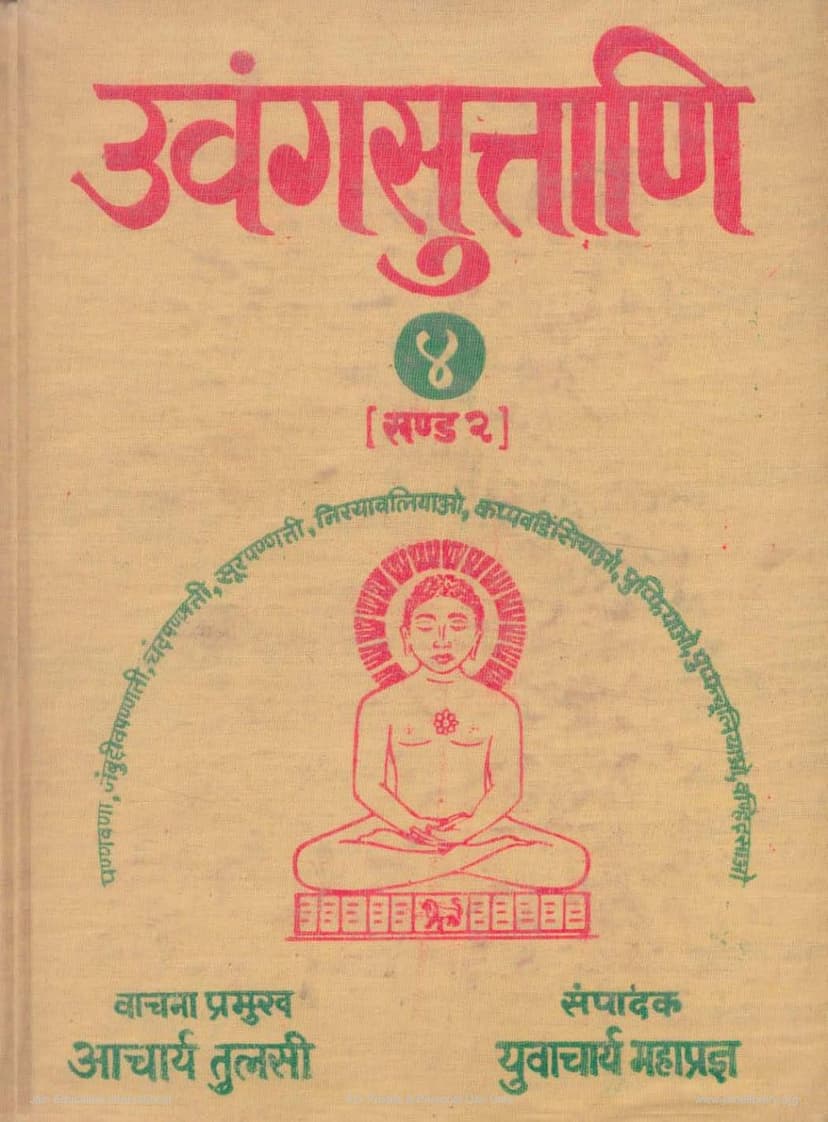Agam 19 Upang 08 Niryavalika Sutra Nirayavaliao Terapanth
Added to library: September 1, 2025
Loading image...

Summary
This Jain text, titled "Agam 19 Upang 08 Niryavalika Sutra Nirayavaliao," published by Jain Vishva Bharati and authored by Acharya Tulsi and Yuvaacharya Mahapragna, is the second part of the "Uvangasuttani" (Upanga Sutras) Volume IV. This comprehensive work critically edits and presents nine of the Jain Upanga texts.
Key Information and Content:
- Authorship and Leadership: The project was under the guidance of Acharya TulP, serving as the "Vachana Pramukh" (Chief of Recitation/Guidance), and compiled and edited by Yuvaacharya Mahapragna. The publication is a testament to their dedicated efforts in preserving and disseminating Jain Agamas.
- Scope of the Work: This volume is part of a larger ambitious plan by Jain Vishva Bharati to publish the Jain Agamas in seven series, encompassing critical editions, Sanskrit translations, commentaries, and analytical studies. This specific volume completes the publication of 32 foundational Āgama texts in their original form with variant readings.
- Contents of the Volume: The book contains the critical edition of the original text of the following nine Upanga Āgamas:
- Paṇṇavaṇā (Prajñāpanā): This text extensively discusses the nature of sentient beings (jiva) and insentient beings (ajiva). It classifies vegetable-bodied beings and provides unique insights into societal structures and concepts like "common-bodied" (sadharanasariri), which are compared to socialism. It also details classifications of Aryas and Mlecchas. It is considered a foundational text for Tattva Vidya (Metaphysics).
- Jambuddivapaṇṇatti (Jambūdvīpaprajñapti): This Āgama focuses on Jambūdvīpa, the central continent in Jain cosmology. It details its geography, the lineage of Rishabhadeva, the concept of time cycles, the descriptions of Bharata Cakravarti (including his fourteen jewels and nine treasures), and the Kalacakra (wheel of time). The text is divided into seven chapters called "Vakkhāros" or "Vakshakaras." It is noted for its prophetic descriptions of the era of decline and the potential for atomic warfare.
- Candapannatti (Chandraprajñapti): This text deals with the celestial body of the Moon.
- Sūrapannatti (Sūryaprajñapti): This text focuses on the celestial body of the Sun. Notably, the complete text of Candraprajñapti is not available, and the available portion largely overlaps with Sūraprajñapti, suggesting a close relationship or that the current version of Candraprajñapti is primarily Sūraprajñapti.
- Niryāvaliyāo (Niryāvaliya): This Āgama, also known as "Kalpika," deals with the consequences of actions (karma vipāka). It covers themes like virtuous and vicious conduct, the consequences of karma, and the path to salvation. It includes narratives such as the battle between Chetaka and Konika, the destinies of Shrenika's ten grandsons, the violation and observance of restraint and right faith, the teachings of Pārśvanātha's ten female disciples, and the conduct of the twelve princes of the Vṛṣṇi dynasty.
- Kappavādisiyāo (Kalpavāḍisiyā): (The specific content of this Upanga is not detailed in the provided excerpts but is listed as part of the volume.)
- Pupphiyāo (Puṣpiyā): (The specific content of this Upanga is not detailed in the provided excerpts but is listed as part of the volume.)
- Puşphacūlīyāo (Puṣpacūlīyā): (The specific content of this Upanga is not detailed in the provided excerpts but is listed as part of the volume.)
- Vanhidasāo (Vṛṣṇidaśā): (The specific content of this Upanga is not detailed in the provided excerpts but is listed as part of the volume.)
- Editorial Process and Challenges: The editors emphasize the arduous nature of compiling and editing ancient texts, especially those thousands of years old, with evolving language and meanings. They highlight the importance of critical analysis, consulting multiple manuscripts, and relying on commentaries. The text mentions the use of four manuscripts for Paṇṇavaṇā and seven for Jambudivapannatti, along with extensive cross-referencing and critical analysis of textual variations.
- Word Index: For the convenience of readers and scholars, a joint word index for the nine Āgamas in this volume is appended.
- Support and Collaboration: The publication received significant financial and intellectual support from various individuals and institutions, including the Saravagi Charitable Fund, Shri Ramlal Hansraj Golchha, and others, as well as the dedication of numerous monks and nuns who assisted in the editing and proofreading.
- Significance: The critical editing of these 32 Āgamas is considered a landmark achievement, making this ancient Jain literature accessible to scholars and the public for the first time in such a comprehensive and critical manner.
In essence, this volume represents a monumental effort to present core Jain philosophical and cosmological texts in a scholarly, critically edited format, preserving them for future generations. The work meticulously details the content, historical context, and editorial challenges faced in bringing these ancient scriptures to light.